Those of you born in December, are triply blessed with three birthstone choices; tanzanite, zircon and turquoise. If blue is your favorite color, these three birthstones provide a wide variety of shade choices. If blue isn’t your color, you’re still able to choose from bright red, yellow, green, purple and brown gems. These very different gemstones also offer a wide range of jewelry possibilities. This blog provides information about turquoise, while tanzanite gemstones and zircon gemstones are covered in separate blogs.
Turquoise is a blue to green colored semi-translucent to opaque stone. It can be used as both a polished gem for jewelry or carved as an ornamental material. Some turquoise gemstones contains veins of matrix (remnants of the rock in which it formed) running through it. It’s best known for a beautiful blue color which is compared with an azure sky and robin’s eggs.
We have not created any jewelry designs containing turquoise, but have designed pieces made from December’s other two birthstones, tanzanite and zircon, as seen here:
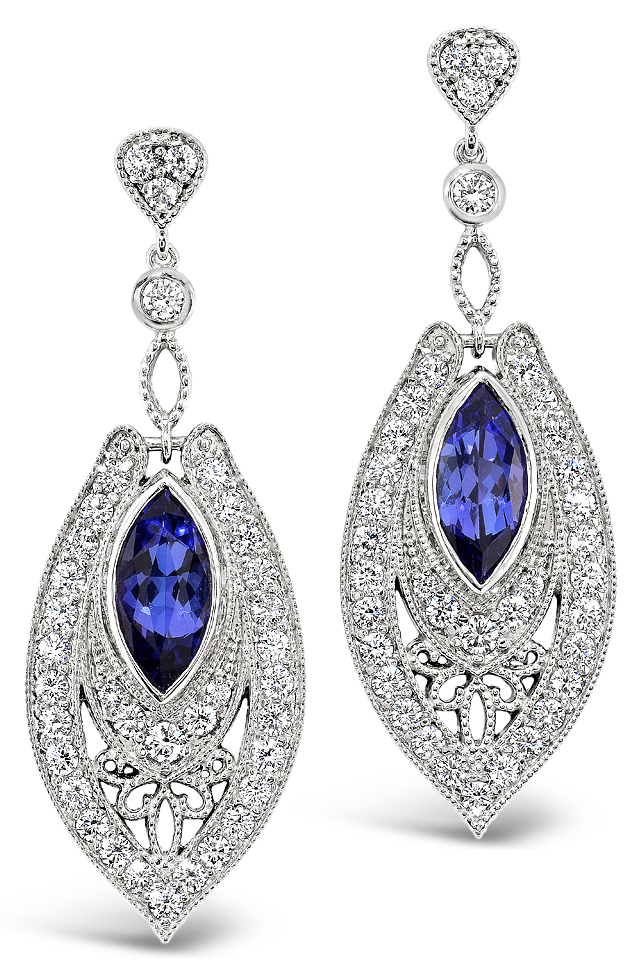
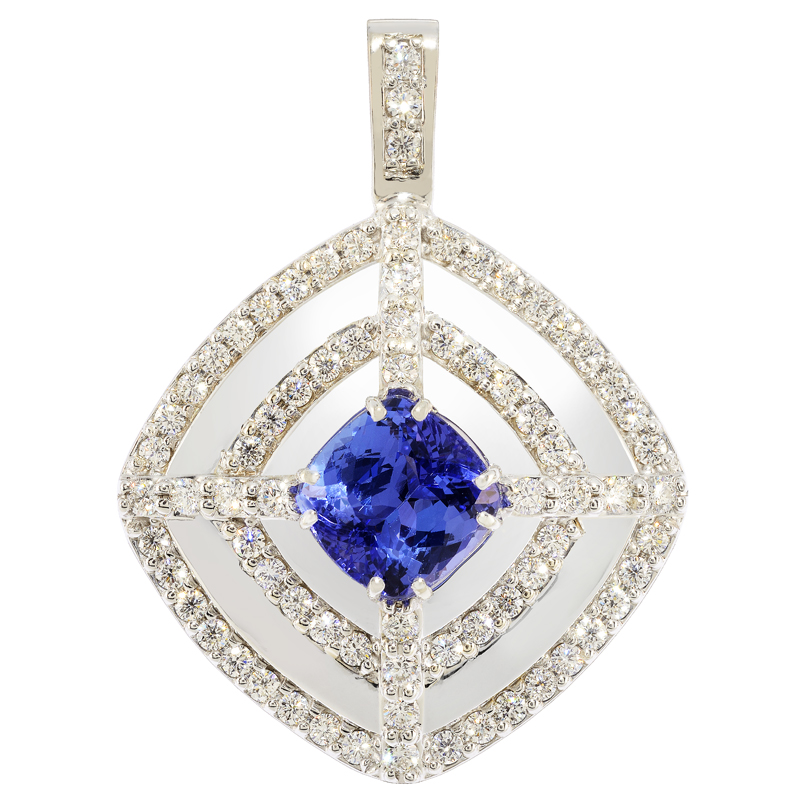
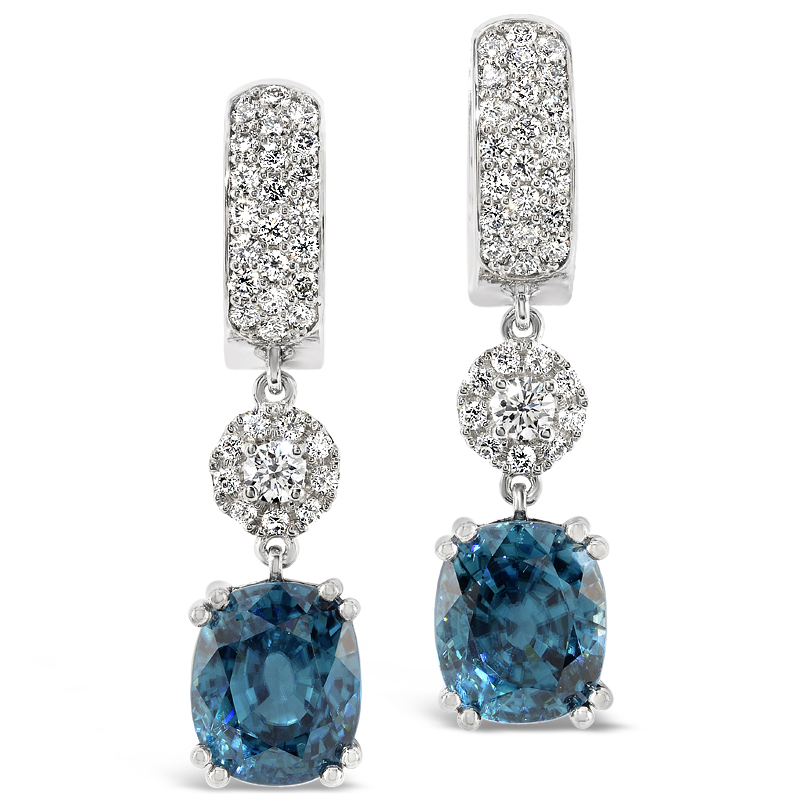
To view 100 East Fine Jewelry’s current December birthstone options, click the links for the 100 East Fine Jewelry Tanzanite Collection or the 100 East Fine Jewelry Zircon Collection.
In addition to being a December birthstone, turquoise is also the gem of the 11th wedding anniversary.
History and Lore
This striking blue gemstone’s name, “turquoise,” dates back to the thirteenth century French expression “pierre tourques”, or “Turkish stone.” The name reflects that turquoise likely first arrived in Europe from Turkey.
Turquoise’s popularity spans millennia and many cultures. It was treasured by ancient civilizations in Egypt, China and Mesoamerica (A historic region comprised of modern day northern Costa Rica, Nicaragua, Honduras, El Salvador, Guatemala, Belize, and central to southern Mexico).
Ancient Egyptians’ reverence for turquoise can be traced back over 5000 years; as far back as their first pharaoh. Archaeological excavations revealed pharaohs and other rulers of ancient Egypt bedecked themselves with turquoise jewelry. It even adorned the gold funerary mask of King Tut (1334 BC to around 1316 BC). Chinese artisans were carving it more than 3,000 years ago.
The Nishapur district
of Iran (formerly Persia) has produced turquoise for over two thousand years
and is regarded as the gemstone’s most valuable source point. The beauty of
Persian turquoise has also been enjoyed by many cultures outside Iran. The Ottoman
Empire (the Ottoman Empire existed from the 14th
to the 20th century, controlling much of southeastern Europe,
western Asia and northern Africa. Its capital was Istanbul/Constantinople) and
Indian treasures contain many valuable objects
set with turquoise. The British aristocracy and Royal family also seem to enjoy
turquoise jewelry, especially tiaras. It is considered as sacred by Native
Americans and is one of the main gemstones seen in their jewelry. The styles
and techniques vary in different regions of the Americas. Turquoise was a
ceremonial gem and a medium of exchange for Native American tribes in the
southwestern United States, who also used it in jewelry and amulets. It appears
in jewelry belonging to more modern British royalty. Wallace Simpson
(1896–1986), Duchess of Windsor (the woman for whom King Edward VIII gave up
his throne), wore a famous amethyst and
turquoise necklace made by Cartier.
Held in high regard
by many cultures, including Tibet where it’s the national gem, it’s believed to
grant good health, good fortune, promote wealth, luck and healing, as well as providing
protection from evil. It was thought to
possess many beneficial powers, like guaranteeing health and good fortune. From
the 13th century on, it was accepted to protect the wearer from falling,
especially off horses, and would break into several pieces at the approach of
disaster. Hindu mystics maintained that seeing a turquoise after beholding the
new moon ensured fantastic wealth. In European
tradition, the gift of a turquoise ring means “forget me not.”
Turquoise also played an important role in the lives of Native Americans. Apache
Indians maintained turquoise could be found by following a rainbow to its end.
They also believed attaching it to a bow or firearm increased a hunter or warrior’s accuracy. The Pueblo Indians felt
turquoise got its color from the sky, while the Hopi thought the gem was
produced by lizards scurrying over the earth.
Use in Jewelry Today
Although much of today’s turquoise jewelry is sleek and modern, many US consumers are more familiar with traditional Native American jewelry. The popularity of traditional Native American jewelry in the mainstream jewelry industry, however, comes and goes.
Turquoise might lack the sparkle and clarity of transparent colored gemstones, but its combination of heritage and unforgettable color make it a desirable gem for use in jewelry. Besides color and color uniformity, jewelry-quality turquoise is judged on two additional quality factors; texture/luster and presence or absence of matrix.
Turquoise’s luster is a function of its composition; the aggregation of microscopic crystals to form a solid mass. If the crystals are packed densely, the material is less porous, which means it has finer texture. Fine-textured turquoise has an attractive, waxy luster when polished. Turquoise with a less-dense crystal structure has higher porosity and coarser texture, resulting in a duller luster when polished. Gems with fine texture are more valuable than those with coarse texture.
The other major factor in judging a turquoise gemstone’s quality is matrix content. Matrix in a turquoise gemstone is remnants of host rock it was found in when it was mined. Matrix may appear as narrow black, brown, or tan veins of the host rock. Cutters strive to fashion turquoise so no matrix is visible, but sometimes it’s unavoidable. Small amounts of turquoise might be scattered through host rock in such a way that the rough material can’t yield cut specimens large enough to fashion into gems without including some matrix. The presence of matrix can lower the value of turquoise, but that doesn’t mean turquoise with matrix is unmarketable. Some contain fine seams of matrix in thin, delicate, web-like patterns across the face of the gemstone. The patterns provide a dark contrast to the gem’s bright blue and is known as spider web turquoise. In the market, all other factors being equal, top-quality turquoise stones with no matrix command the highest prices. Gems with attractive spider web matrix rank second in value.
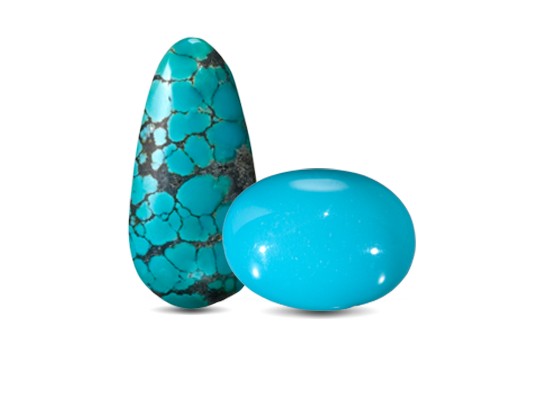
Polished turquoise photo credit to GIA
Stones that display an unblemished, intense, fine textured sky blue or robin’s egg blue color without matrix are considered highest quality. Fine-quality turquoise is pursued around the globe by designers who feature it in unusual and elegant jewelry pieces. Some top-color blue turquoise is engraved with Persian or Arabic inscriptions and inlaid with gold.
Turquoise rough material is plentiful and available in a wide range of sizes. Gem quality rough is most often cut as a cabochon. The smoothly rounded dome shape sets off turquoise’s color, texture, and any matrix beautifully.All sizes of cabochon cut gemstones, even very small ones, are used in Native American jewelry. Turquoise rough is also made into beads, carvings, and inlays. Manufacturers and artisans fashion various shaped turquoise beads into necklaces and bracelets. Small, flat pieces are popular for use in jewelry inlays. Large pieces of turquoise rough are popular for carvings. Lower-quality rough material might be tumbled into “nuggets."
Turquoise is generally stable to sunlight, but high heat can cause discoloration and breakage. Its lower hardness and porosity can result in damage by acids and discoloration by certain chemicals, cosmetics and even skin oils or perspiration. Thus, turquoise requires special care. Regular cleaning with soft wet cloth is highly recommended. It should never be cleaned with harsh cleaning agents, steam or ultrasonic cleaners. We believe all your gemstone jewelry is best cleaned with warm, soapy water and a soft brush. We consider this a single, safe method to use for cleaning all gemstone jewelry. For additional details, please read our blog; Cleaning Fine Gemstone Jewelry. To learn about caring for all your fine jewelry, please read our blog; Caring for Fine Gemstone Jewelry.
Color Characteristics and Treatments
Turquoise gemstones are semi-translucent to opaque. Its color can range from dull greys and yellows to grass greens to a bright, medium-toned sky blue. It’s often mottled and sometimes has dark splotches and may contain veins of matrix. The most valuable turquoise is a uniform medium blue, with no matrix and the ability to take a good polish. The most-prized turquoise color is a uniform, intense, medium blue, sometimes referred to as robin’s egg blue or sky blue in the trade. The traditional source for this color is the Nishapur district of Iran, which is frequently referred to as “Persian blue,” whether or not it was actually mined in Iran.
Generally speaking, turquoise with a green to greenish blue color is less desirable than turquoise with a pure blue hue. However, color choice ultimately depends on personal preference. Some contemporary designers actively seek avocado and lime green turquoise.
Collectors and consumers should be aware of a number of turquoise simulants and treatments which can turn up in the jewelry marketplace.
Simulants - The term “simulant” refers to materials that look like another gem and are used as its substitute but have very different chemical composition, crystal structure and optical and physical properties. These simulants, also known as imitations, can be natural or manmade. Turquoise simulants include:
- Plastic is commonly used to imitate turquoise in inexpensive fashion jewelry. However, it can also be manipulated into convincing imitations. Plastic is not very durable.
- Ceramic beads are occasionally used as a turquoise simulant. Ceramic can be any product made from a nonmetallic material by firing at high temperature. During this process, a finely ground powder is heated and sometimes placed under pressure to recrystallize and harden it to produce a fine-grained imitation.
- In the early 1970’s, a company named Gilson developed a process for creating an imitation turquoise, which can occasionally be found in the market.
Turquoise Treatments – Treatments are processes used to alter the color, clarity, or improve the durability of gems. Color and color uniformity are extremely important factors in turquoise value. Also, being a relatively soft mineral with a porous structure, turquoise with a coarser texture are also less desirable. These traits can also affect durability. Because of these factors, a number of treatments have been developed and can be found in the jewelry market.
- Dyeing
porous or fractured turquoise gems to change their color. The fractures are
sometimes purposely created by heating the gem so that an otherwise non-porous
material can more readily accept dye.
- Durability – dyeing may be long-lived but is ultimately dependent on the stability of the dye itself. The dye may sometimes leak out of gems with large fractures. Many dyes can be removed if the gem comes into contact with a solvent such as alcohol. Some dyes are unstable when exposed to sunlight and can fade over time.
- Special care – avoid contact with solvents or exposing them to prolonged periods of sunlight, such as sitting them by a sunny window. This could cause the dye to fade.
- Impregnation
is immersing the surface of a porous gemstone with a polymer, plastic, wax or
oil to improve its appearance and/or give it greater durability. This treatment
is seen frequently in the trade.
- Durability – Plastic and wax coatings are thin and have low melting points, which makes them susceptible to heat damage. Plastic and polymer impregnations are considered stable and durable as long as they are not subjected to heat or chemicals. Wax and oil are considered less stable.
- Special care – Care must be taken not to subject impregnated gemstones with heat, such as that encountered by a jeweler’s torch.
- Also seen are cavities in a gemstone filled with a metal-loaded epoxy to imitate matrix.
Formation, Mining and Cutting
Turquoise is found in only a few places on earth: dry and barren regions where acidic, copper-rich groundwater seeps downward and reacts with minerals that contain phosphorus and aluminum. The result of this sedimentary process is a porous, semi-translucent to opaque compound of hydrated copper and aluminum phosphate. Turquoise deposits usually form in iron-rich limonite or sandstone host rock. Limonite creates dark brown matrix in turquoise, while sandstone creates tan matrix.
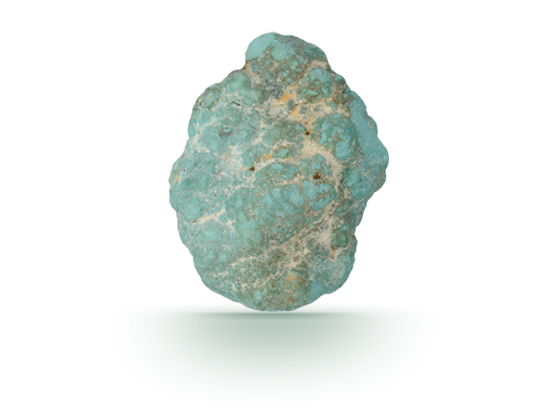
Turquoise rough photo credit to GIA
Turquoise is sourced from Iran, the US, Mexico, Chile, China and Tibet. Its color and purity may vary by source site.
For more than 2000 years, the Nishapur district of Iran, formerly Persia, has been the traditional source for top color, “Persian blue” (aka robin’s-egg blue or sky blue).
The US state of New
Mexico was the largest producer of turquoise in until the 1920s. However, today
most U.S. production comes from Arizona and Nevada, where mines have evocative
names like Dry Creek, Easter Blue, Emerald Valley and Fox. The Kingman mine in
Arizona is a historically important source known for producing intense blue
turquoise. Now closed to turquoise mining, Arizona’s Sleeping Beauty mine was a
prolific producer for more than four decades.
Today, China is the world’s largest producer of
turquoise, with the Hubei Province, in central China, the source of most of the
gem-quality material.
Since turquoise is opaque and rarely translucent, it is normally cut into cabochons and beads for use in jewelry. Some cutters work around large areas of matrix to yield pieces of evenly colored turquoise. Being relatively soft, it’s also ideal for carving. European, Asian, Middle Eastern, and Native American artists choose turquoise as a medium for free-form carved art objects. It’s often fashioned into talismans with Native American significance, such as bird and animal carvings, called fetishes.
Famous Turquoise
The Persian Tiara - Princess Margaret (1930 to 2002), sister of the current Queen Elizabeth, received a collection of turquoise-laden jewels from her mother, Queen Elizabeth, The Queen Mother on the occasion of her 21st birthday. The centerpiece of the collection was The Persian Tiara, which also included a necklace, matching pendant earrings and a large square brooch among other pieces. Also known as The Triumph of Love Tiara, it contained “Persian” turquoise and diamonds and was set in gold and platinum. The tiara was created by the famous jeweler, House of Garrard in the early 1900’s.
Credit American Gem Trade Association, Gemological Institute of America and Gemworld International.
